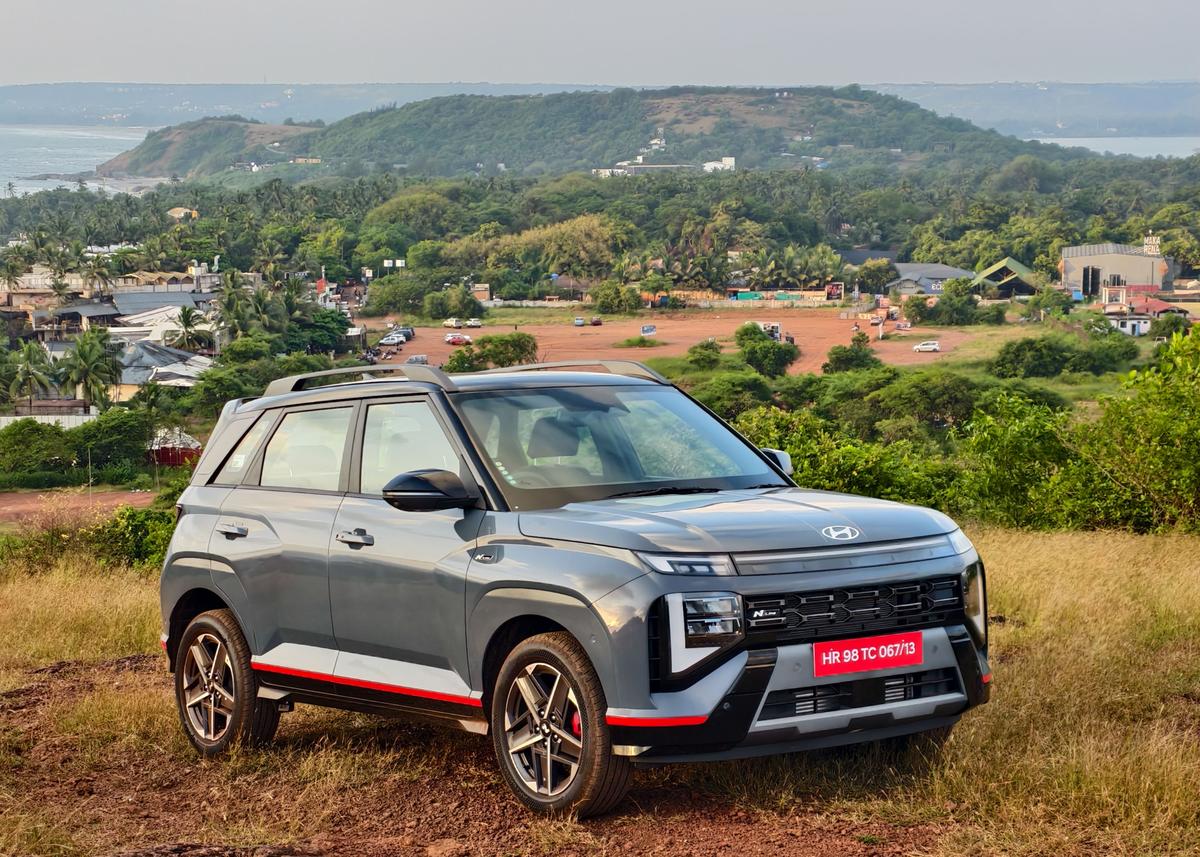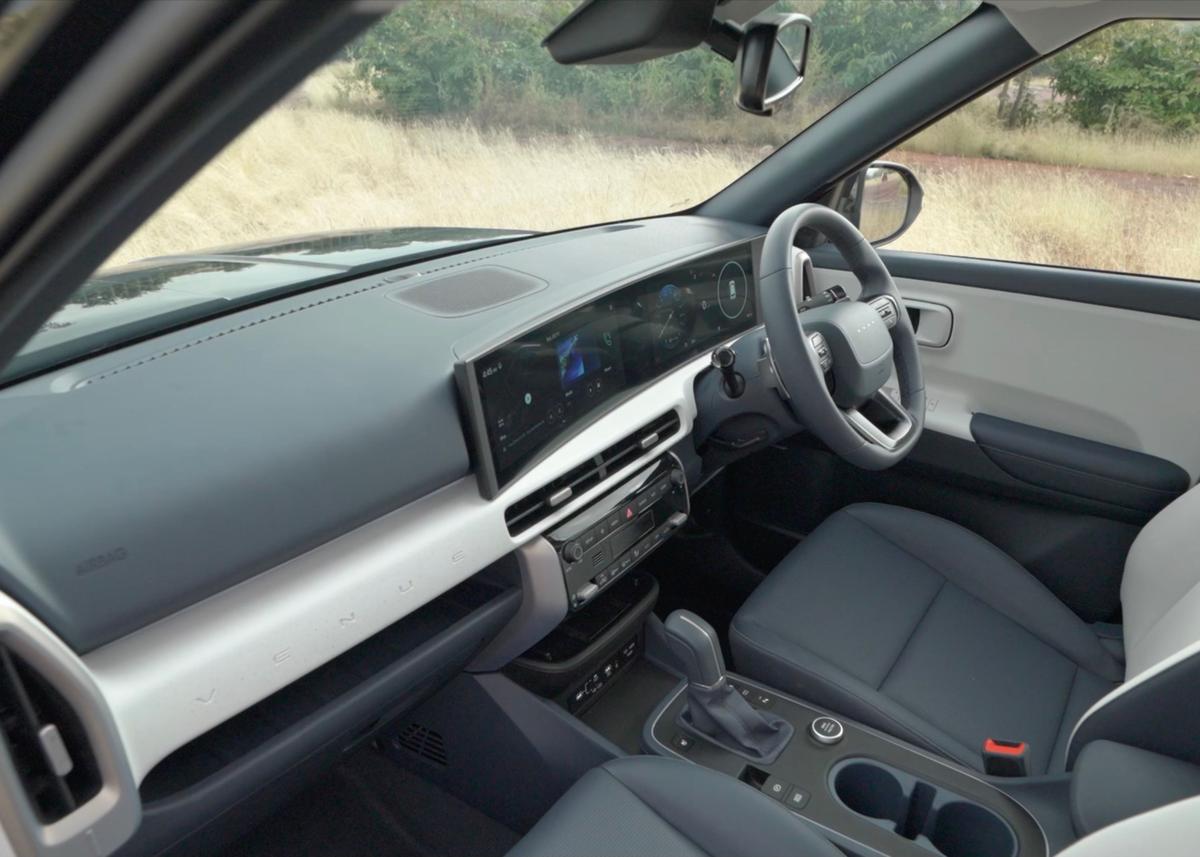The new Hyundai Venue no longer feels like a compact SUV. It looks and behaves like something far more grown up — and that is entirely by design. Hyundai has re-engineered and redesigned it to be taller, wider, and longer in wheelbase, giving it a stronger, more confident stance that is reminiscent of the Creta. The design is bold and assertive, dominated by Hyundai’s parametric grille, horizon-style LED DRLs, and connected LED tail lamps. There is a sense of substance now, a hint of SUV maturity that the old Venue never quite managed to pull off. Even the N Line variant doubles down on that image, with red accents, R17 alloys, and twin-tip exhausts that lend it a sportier, more dynamic personality.
Inside, Hyundai has truly raised the bar. The cabin feels richer, more layered, and clearly built to impress. The twin 12.3-inch curved panoramic displays immediately dominates the dashboard — one for the instrument cluster and the other for the infotainment hub, both powered by Hyundai’s NVIDIA-based ccNC system. It is fast, slick, and visually stunning. The materials, too, are mostly excellent, from the soft-touch panels to the leatherette upholstery and ambient lighting. The Bose sound system, wireless smartphone connectivity, and voice-enabled sunroof all contribute to a cabin experience that feels one step ahead of its class.
Twin 12.3-inch curved displays and premium materials give the cabin a distinctly upmarket vibe.
| Photo Credit:
Special Arrangement
There is a sense of space and comfort that the older Venue lacked. The rear seats now recline, knee room has noticeably improved , and thoughtful additions such as the rear sunshade and a 4-way powered driver’s seat give it a distinctly premium touch.
Hyundai has done its homework on comfort and convenience. But not every choice feels inspired. The moulded plastic on the centre console, for instance, does not quite match the overall premium feel of the cabin. It is hard, a bit hollow, and somewhat out of place in an otherwise well-finished interior. Then there is the placement of the reverse lights — tucked low into the rear bumper. For India’s chaotic traffic and tight parking spaces, that is a practical misstep. In a country where tight squeezes, impatient bikers, and fender-benders are part of daily life, that design detail could prove costly. Small issues? Yes. But ones that could bother everyday owners more than Hyundai might expect.
Out on the road, the new Venue delivers exactly what you would expect from a modern Hyundai — refinement. The suspension setup is well-judged, offering a planted, composed ride over rough patches while keeping things smooth in the city. It feels more mature , calmer than before, and perfectly suited to the daily grind as well as long weekend drives. The steering is light but direct, the brakes feel solid, and the cabin insulation keeps most of the outside world where it belongs — outside.

Reclining rear seats, ambient lighting, and a powered driver’s seat make the Venue feel a class above.
| Photo Credit:
Special Arrangement
The engine lineup, however, feels all too familiar. Hyundai continues with the 1.2-litre naturally aspirated petrol, the 1.0-litre turbo-petrol, and the 1.5-litre diesel. While they are all proven units, they don’t exactly inject excitement into the mix. The 1.2 NA engine, in particular, feels underwhelming — it struggled to make the smaller Exter feel lively, and in the heavier Venue, it feels even more sluggish. The turbo-petrol is smoother and pairs well with the 7-speed DCT, but its character leans toward comfort rather than thrill. The diesel remains the practical choice — torquey and efficient — but it doesn’t elevate the driving experience.
And that’s where the Venue begins to lose ground to its rivals. The Skoda Kushaq and VW Taigun mid variants, with their TSI engines, feel more engaging to drive. The Mahindra XUV 3XO brings punchy performance, robust value, and a sense of freshness to the table. Even the Kia Sonet, which has consistently outsold the Venue since launch, manages to feel a touch more cohesive in how it balances style, power, and polish. Hyundai’s refinement remains its biggest strength — but also, perhaps, its limitation.

With over 65 safety features and Level 2 ADAS, the new Venue brings Hyundai’s most advanced safety suite yet.
| Photo Credit:
Special Arrangement
Safety, though, is one area where Hyundai has clearly stepped up. The new Venue gets over 65 safety features, 33 of which are standard, along with Level 2 ADAS. The chassis uses 71% high-strength steel, there are six airbags, ESC, all-disc brakes, and a host of driver-assist functions. It is a genuine move forward — one that finally puts Hyundai in a stronger safety conversation in India.
Yet, even as the Venue impresses, a note of concern lingers. And the pricing tells its own story. The base variant at ₹7.89 lakh is mostly a formality — a marketing number anchored by that underpowered 1.2-litre engine. The real Venue — the one with the features, tech, and power trains people will actually want — costs between ₹13 to ₹15.69 lakh. And at that price, it’s treading in the same waters as its own sibling, the Creta, and segment rivals like the mid level variants of the Seltos, Kushaq, and Taigun. The irony is hard to ignore: the compact SUV that once sat neatly below the Creta is now knocking on its door.
And that poses a bigger problem for Hyundai. The Creta has been the brand’s lifeline in India — its one true blockbuster. The Verna, Alcazar, and Exter have not managed to deliver consistent numbers, leaving Hyundai’s SUV strategy resting almost entirely on the Creta’s shoulders. By pushing the Venue upward, Hyundai risks cannibalising its own star performer — and just as the Creta prepares to face fresh heat from the new Kia Seltos launching this December. The Venue’s climb upmarket, combined with the Seltos’ renewed assault, could squeeze Hyundai from both sides — its compact SUV competing internally, and its bestseller facing external pressure.

The Venue’s upmarket move reflects Hyundai’s confidence — but also its toughest balancing act yet.
Hyundai Venue 2025 review
| Photo Credit:
Special Arrangement
Then there’s the timing. The compact SUV segment is already overflowing with strong contenders. The Kia Sonet remains a customer favourite, the Mahindra XUV 3XO is rewriting the value equation, the Tata Nexon continues its stronghold, and the quietly emerging Skoda Kylaq brings solid build and TSI performance to the mix. The Venue, though improved in every measurable way, feels like it is entering a conversation that has already moved on.
There’s no questioning the effort behind this car. It is stylish, comfortable, loaded with features, and undoubtedly safer than ever before. It reflects Hyundai’s growing engineering maturity and its understanding of Indian buyer aspirations. Yet ambition and timing don’t align perfectly. The new Venue represents a significant step forward — one that commands respect. Yet, it also feels like a car caught between its own identity and its maker’s ambition.
Hyundai has built a fine SUV here, but whether it’s the right car for this moment and this market remains uncertain. The Venue’s success is far from assured, and for once, Hyundai might find itself waiting to see if India agrees with the price of progress.
Hyundai Venue Price Range: 7.89 lakh – 15.69 lakh (ex-showroom)
Motorscribes, in association with The Hindu, brings you the latest in cars and bikes. Follow them on Instagram
